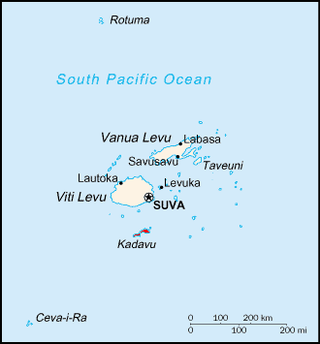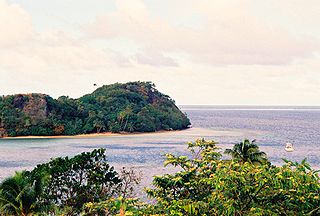In Hawaiian mythology, the Kupua are a group of supernatural entities which might be considered gods or spirits.

Kadavu, with an area of 411 square kilometres (159 sq mi), is the fourth largest island in Fiji, and the largest island in the Kadavu Group, a volcanic archipelago consisting of Kadavu, Ono, Galoa and a number of smaller islands in the Great Astrolabe Reef. Its main administrative centre is Vunisea, which has an airport, a high school, a hospital, and a government station, on the Namalata Isthmus where the island is almost cut in two. Suva, Fiji's capital, lies 88 kilometres to the north of Kadavu. The population of the island province was 10,167 at the most recent census in 2007.

Deep Sea Monster Reigo also known as Reigo: The Deep-Sea Monster vs. the Battleship Yamato is a 2008 independently-made Japanese tokusatsu kaiju film by Shinpei Hayashiya. Veteran artist Keita Amemiya designed the titular monster. The film's original working title was Reigo vs. Yamato.
In Caribbean folklore, the Lusca is a name given to a sea monster said to exist in the region of the blue holes nearby Andros, an island in the Bahamas.

"Dagon" is a short story by American author H. P. Lovecraft. It was written in July 1917 and is one of the first stories that Lovecraft wrote as an adult. It was first published in the November 1919 edition of The Vagrant. Dagon was later published in Weird Tales in October 1923. It is considered by many to be one of Lovecraft's most forward-looking stories.

Dravuni is a volcanic island in the Kadavu Group of islands in Fiji. Covering an area of 0.8 km2 (0.3 sq mi), it is located at 18.78° South and 178.53° East, and reaches a maximum altitude of 40 metres (131 ft).

Moala is a volcanic island in the Moala subgroup of Fiji's Lau archipelago. It has an area of 62.5 square kilometers (24.1 sq mi), making it the ninth largest island of Fiji. The highest point on the island of Moala, at a maximum elevation of 468 meters (1,535 ft), is called Delaimoala which has rich vegetation and consists of dark thick forest. The population of around 3000 live in eight villages. The chief village of Naroi, whose population is over 500, was formalised during the colonial era to entertain those that would not be entertained elsewhere. Economic activities include coconut farming, cocoa production, fishing and yaqona (kava) production.

Religiously, Fiji is a mixed society, with Christianity and Hinduism being the main faiths.
Wani was a dragon or sea monster in Japanese mythology. Since it is written using the kanji 鰐wani is translated as "crocodile", or sometimes "shark".

Fijian cuisine has long consisted of primarily foraged and farm-grown food. Although rice, wheat, and tea all became staples during Fiji's colonial era, native Fijians still eat primarily tubers and coconuts. The cuisine of Fiji is known for its seafood and various green vegetables, including ''ota'', a young forest fern, and ''bele'', a plant that resembles spinach.

The Great Astrolabe Reef is in Fiji and surrounds the fourth largest island, Kadavu Island, which is approximately 65 km in length. Kadavu Island is approximately 100 km south of Viti Levu, the main island of Fiji.
Olifat is a trickster god in Micronesian mythology.

Cook Islands mythology comprises historical myths, legends, and folklore passed down by the ancient Cook Islanders over many generations. Many of the Cook Islands legends were recited through ancient songs and chants. The Cook Islands myths and legends have similarities to general Polynesian mythology, which developed over the centuries into its own unique character.
Niuean mythology relates to some of the myths prevalent on the island of Niue, an Oceanic island country in free association with New Zealand. Although Niuean mythology reports a colonization before 500 AD, the island was settled by Polynesians from Samoa around 900 AD. The five principal gods of Niue are known as the tupua, and include Fao, Huanaki, Fakahoko, Laga-iki, and Lagi-atea, who by various accounts, arrived from Fonuagalo, Tulia, Toga-liulu, or perhaps other islands. In Avatele myths, the gods are said to have come from within the earth instead of Fonuagalo. There are also many other gods in Niuean mythology from fish gods to flying rats.
Lewalevu is a fertility goddess in Fijian mythology.









